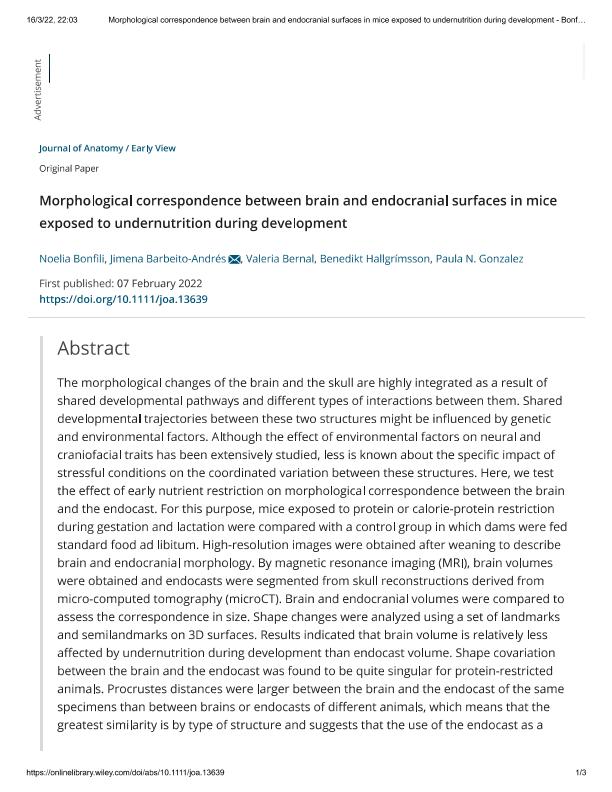Artículo
Morphological correspondence between brain and endocranial surfaces in mice exposed to undernutrition during development
Bonfili, Noelia Sabrina ; Barbeito Andrés, Jimena
; Barbeito Andrés, Jimena ; Bernal, Valeria
; Bernal, Valeria ; Hallgrimsson, Benedikt; Gonzalez, Paula Natalia
; Hallgrimsson, Benedikt; Gonzalez, Paula Natalia
 ; Barbeito Andrés, Jimena
; Barbeito Andrés, Jimena ; Bernal, Valeria
; Bernal, Valeria ; Hallgrimsson, Benedikt; Gonzalez, Paula Natalia
; Hallgrimsson, Benedikt; Gonzalez, Paula Natalia
Fecha de publicación:
03/2022
Editorial:
Wiley Blackwell Publishing, Inc
Revista:
Journal of Anatomy
ISSN:
0021-8782
Idioma:
Inglés
Tipo de recurso:
Artículo publicado
Clasificación temática:
Resumen
The morphological changes of the brain and the skull are highly integrated as a result of shared developmental pathways and different types of interactions between them. Shared developmental trajectories between these two structures might be influenced by genetic and environmental factors. Although the effect of environmental factors on neural and craniofacial traits has been extensively studied, less is known about the specific impact of stressful conditions on the coordinated variation between these structures. Here, we test the effect of early nutrient restriction on morphological correspondence between the brain and the endocast. For this purpose, mice exposed to protein or calorie-protein restriction during gestation and lactation were compared with a control group in which dams were fed standard food ad libitum. High-resolution images were obtained after weaning to describe brain and endocranial morphology. By magnetic resonance imaging (MRI), brain volumes were obtained and endocasts were segmented from skull reconstructions derived from micro-computed tomography (microCT). Brain and endocranial volumes were compared to assess the correspondence in size. Shape changes were analyzed using a set of landmarks and semilandmarks on 3D surfaces. Results indicated that brain volume is relatively less affected by undernutrition during development than endocast volume. Shape covariation between the brain and the endocast was found to be quite singular for protein-restricted animals. Procrustes distances were larger between the brain and the endocast of the same specimens than between brains or endocasts of different animals, which means that the greatest similarity is by type of structure and suggests that the use of the endocast as a direct proxy of the brain at this intraspecific scale could have some limitations. In the same line, patterns of brain shape asymmetry were not directly estimated from endocranial surfaces. In sum, our findings indicate that morphological variation and association between the brain and the endocast is modulated by environmental factors and support the idea that head morphogenesis results from complex processes that are sensitive to the pervasive influence of nutrient intake.
Archivos asociados
Licencia
Identificadores
Colecciones
Articulos(ENYS)
Articulos de UNIDAD EJECUTORA DE ESTUDIOS EN NEUROCIENCIAS Y SISTEMAS COMPLEJOS
Articulos de UNIDAD EJECUTORA DE ESTUDIOS EN NEUROCIENCIAS Y SISTEMAS COMPLEJOS
Citación
Bonfili, Noelia Sabrina; Barbeito Andrés, Jimena; Bernal, Valeria; Hallgrimsson, Benedikt; Gonzalez, Paula Natalia; Morphological correspondence between brain and endocranial surfaces in mice exposed to undernutrition during development; Wiley Blackwell Publishing, Inc; Journal of Anatomy; 241; 1; 3-2022; 1-12
Compartir
Altmétricas



